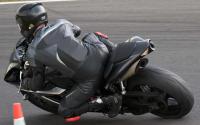Grizzly G1006 Milling Machine CNC Conversion
- BigJohnT
-

- Offline
- Administrator
-

- Posts: 6999
- Thank you received: 1176
Some suggestions to get started
- Install LinuxCNC in your computer
- Run the Latency Test for several hours
- Create a config using Stepconf Wizard or copy a sample config
- Connect up your drives and steppers and verify that they work as expected
- Install the steppers and use the VFD manually
- Start making parts while you consider the next steps
John
Please Log in or Create an account to join the conversation.
- BruceLayne
- Offline
- Junior Member
-

- Posts: 39
- Thank you received: 0
I was considering the simple open loop stepper solution first, but I thought I'd pick the collective brain to avoid unwiring everything when I wanted to add encoders later.
I looked at the many offerings from MESA, but didn't see anything optimized for my unusual configuration with stepper motors and encoders. They have a good solution for steppers (5i25+7i76) and there's a good servo and encoder solution (5i25+7i77). I guess I could get the 7i77 solution and just leave the stepper motors connected to the parallel port.
I wasn't so much wanting the encoders to close the loop on the steppers and run them like servos. I mostly wanted the encoders to detect a rare following error, fault out, and stop the machine. I'm leery of open loop machines that could hit some harmonic zone, lose a few hundred steps, and then continue machining with a gross positional error like nothing ever happened. I won't be running this thing unattended for hours. It ain't that kind of machine. My jobs run for a few seconds or a few minutes. I'll be there as a part loading monkey, so I can detect any problems related to open loop operation. My parts are inexpensive, so the occasional scrapped part won't make me suicidal.
With the beefy 1600 ounce inch stepper motors, I may not need to worry too much about encoders to detect lost steps. The open loop stepper motors and manual spindle speed control may serve me well for a long time, and ultimately may be all that this import mill deserves. I'll probably want to upgrade to inexpensive ball screws, but all of my current production work is linear motions and the backlash isn't a problem. I could probably program the huge backlash into LinuxCNC as a backlash compensation to make it easier to write my point to point G code programs, lube up those Acme screws, and keep on truckin'. KISS.
I'll post some pictures when the stepper hardware arrives later this week, I'll post pictures and drawings of the motor mounts I create to mount the NEMA 34 motors, and I'll post a video of the machine making parts.
I guess it's time to buy another Sam's Club roll around tool cart to house the CNC electronics and the CNC PC, and find someplace in my cluttered basement shop to put it.
Please Log in or Create an account to join the conversation.
- BigJohnT
-

- Offline
- Administrator
-

- Posts: 6999
- Thank you received: 1176
A huge backlash compensation can be a pain to actually get it to work. At direction reversal the stepgen tries to move to the compensated position immediately. Better to try and fit some anti backlash to the acme nut until you get the ball screws installed. In any case if you use backlash make sure you make the adjustments to stepgen max acceleration.
At the end of each part if you go to a predefined position with match marks to check that would give you a quick visual that all is well. You can also use the match marks to home the machine until you fit it with limit switches which can be used to home to as well.
Also keep in mind that the 1600 ounce inch rating is while the stepper is not moving ie. how hard it tries to stay still.
John
Please Log in or Create an account to join the conversation.
- andypugh
-

- Offline
- Moderator
-

- Posts: 23451
- Thank you received: 4989
Indeed there is. You need a capacitor and a resistor. The first picture hereThere is probably some simple and cheap hardware that will allow LinuxCNC to generate that analog control voltage
www.linuxcnc.org/index.php/english/compo...id=27&id=24915#24915
You then set up a PWM module in HAL to output a PWM on a parallel port pin, then filter that to a DC voltage.
This might not be the ideal answer, as the voltage is sourced from the parallel port, not the VFD +10V (or whatever).
To emulate a potentiometer a slightly more complex solution is required.
You need an opto-isolator with a totem-pole output. This is important as you need a push/pull output to discharge the capacitor at logic-false and charge it at logic-true.
I used: uk.rs-online.com/web/p/products/734-4962/
Please Log in or Create an account to join the conversation.
- BruceLayne
- Offline
- Junior Member
-

- Posts: 39
- Thank you received: 0
I'm an EE, so the circuit is actually less valuable to me than the confirmation of the PWM signal generation in LinuxCNC. I may make am op amp circuit that can generate +/- 10VDC or 0 to 10 VDC and publish it for others to use.
My strategy will probably be to get the new spindle motor mounted and running from the VFD. I already ran the 220 VAC outlet for the milling machine when I installed the outlet for the lathe, so that unpleasant task is done. I'll get the VFD running in manual mode from the front panel and it'll be very usable for my simple needs. Then, I'll get the spindle under LinuxCNC control with PWM with the current VFD, or I'll buy a new VFD and use Modbus via the RS-232 port, through a converter to RS-485... whichever looks easier. I'm all about easier..
Thanks!
Please Log in or Create an account to join the conversation.
- andypugh
-

- Offline
- Moderator
-

- Posts: 23451
- Thank you received: 4989
www.linuxcnc.org/docs/html/hal/rtcomps.h...en_a_id_sec_pwmgen_aI'm an EE, so the circuit is actually less valuable to me than the confirmation of the PWM signal generation in LinuxCNC.
The circuit probably wants to emulate a Potentiometer, as that is what most drives expect. It is worth bearing in mind that some drives (the KBIC controllers for example) float the pot at mains voltage.I may make am op amp circuit that can generate +/- 10VDC or 0 to 10 VDC and publish it for others to use.
My first attempt at a controller for a KBIC used a DC-DC converter to create a floating reference voltage and a precision current source. On reflection that simple circuit above would have worked better and more cheaply.
Please Log in or Create an account to join the conversation.
- BigJohnT
-

- Offline
- Administrator
-

- Posts: 6999
- Thank you received: 1176
or I'll buy a new VFD and use Modbus via the RS-232 port, through a converter to RS-485... whichever looks easier. I'm all about easier..
Thanks!
Keep in the back of your mind that Automation Direct GS2 drives are supported in LinuxCNC via modbus over the serial port. You can set the speed, run fwd or reverse and check the status of the drive all from LinuxCNC. I used a 3hp single phase to three phase GS3 on my Bridgeport spindle. The setup is trivial. I did have to get the braking resistor to be able to reverse the spindle for rigid tapping.
www.automationdirect.com/adc/Shopping/Ca...-_460_-z-_575_VAC%29
John
Please Log in or Create an account to join the conversation.
- BruceLayne
- Offline
- Junior Member
-

- Posts: 39
- Thank you received: 0
I noticed that there were examples of using several different VFDs under Modbus control. I took a quick look at the GS2 version, but I need to compare them to see if the LinuxCNC side is similar. Or are there VFD specific Modbus commands? Even if so, I should be able to use the other example code and the Chinese VFD manual to make my own version and add it to the list for cut-and-paste support for the inexpensive Chinese VFD. BTW, what I've been calling the Chinese VFD is manufactured by Huanyang Electronics Company Ltd. Here's the current eBay auction:
www.ebay.com/itm/300652886556
My import mill has a belt driven spindle. I'm using Jon's clever dual gear tooth detector to generate a quadrature encoder on my lathe spindle. I could probably notch the spindle V-belt pully on my milling machine and use the same method, or laser cut a black polycarbonate disk for the spindle pulley and use optical switches in a similar configuration to make a quadrature encoder for the spindle, but I doubt I'll be doing any rigid tapping on that machine! Barring that, a simple one-pulse-per-revolution sensor could be fed to a LinuxCNC counter encoder to verify a rough spindle speed.
Please Log in or Create an account to join the conversation.
- BigJohnT
-

- Offline
- Administrator
-

- Posts: 6999
- Thank you received: 1176
I didn't see the modbus protocol in advert... I'd bet if you had that you could modify the gs2.comp to work with any VFD that communicates with modbus. At least you can see the GS2 modbus info in the manual and if you can compare it to another VFD manual to see if they are close or even the same. I'd assume than anything beyond the modbus communications protocol will not be the same between different VFD's.
John
Please Log in or Create an account to join the conversation.
- andypugh
-

- Offline
- Moderator
-

- Posts: 23451
- Thank you received: 4989
I think Jon Elson has mentioned one type of Chinese VFD which claims to support Modbus but doesn't in practice in any useable way.I didn't see the modbus protocol in advert... I'd bet if you had that you could modify the gs2.comp to work with any VFD that communicates with modbus.
Please Log in or Create an account to join the conversation.

